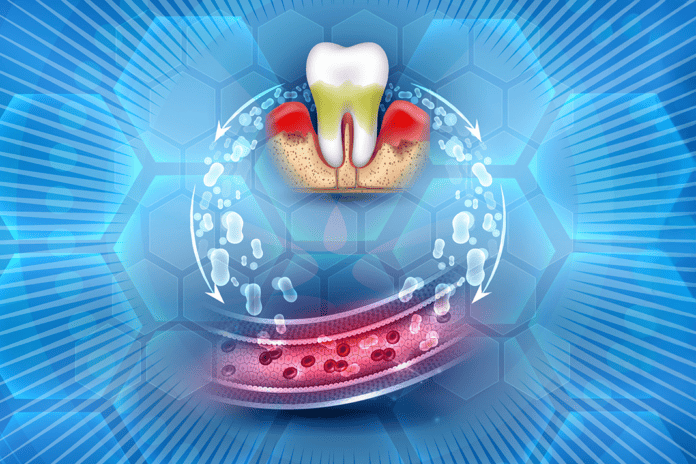Type 2 diabetes is one of the fastest-growing diseases worldwide. The prevalence has more than tripled in the past 20 years. It is expected that the prevalence will continue to increase, leading to the need for better, cost-effective management of type 2 diabetes.1
It is estimated that only one in four adults with type 2 diabetes meets the American Diabetes Association target for blood pressure, cholesterol, and glycosylated hemoglobin (HbA1c) to reduce cardiovascular risk. Uncontrolled HbA1c contributes to micro and macrovascular complications, which often lead to cardiovascular disease. A 1% reduction in HbA1c reduces the risk of diabetes-related health complications by 21%.1
A recently published literature review aimed to “assess whether the inclusion of periodontitis treatment in diabetes management strategies can effectively improve metabolic control.”1
The Review
A comprehensive literature review over a 20-plus-year span was conducted, focusing on pathophysiological associations between periodontitis, diabetes, and atherosclerotic cardiovascular disease. Additionally, the authors investigated inequalities in health care spending.1
Considering the evolution of the research on periodontitis and diabetes, priority was given to more recent studies. Additionally, studies on the systemic impact of periodontitis, standards of care, oral health management, and systematic reviews were given more weight in this literature review.1
The Results
Periodontal disease and dental caries are the leading causes of tooth loss and edentulism worldwide, with an estimated 90% of the population worldwide experiencing some form of oral disease. Yet, worldwide, several countries report a lack of oral health care coverage and inequitable access to care.1
The pathophysiologic mechanisms associated with periodontal disease and diabetes have been attributed to local and systemic inflammation. Individuals with type 2 diabetes have a two to three times higher risk of developing periodontal disease when compared to those without diabetes.1
In a 2015 Cochrane review, the evidence supporting periodontal treatment for managing patients with diabetes was considered insufficient and weak. However, in 2023, a Cochrane review modified its conclusion on this topic, indicating that periodontal treatment improves glycemic control over six months compared to no treatment. This was concluded with a moderate degree of certainty of the updated evidence. This update is consistent with more recent systematic reviews.1
In addition to better glycemic control, D’Aiuto et al. confirmed a reduction in inflammatory markers at six and 12-month follow-ups after periodontal therapy was completed. This study also showed a 10-year reduced risk of coronary heart disease when patients with type 2 diabetes received periodontal treatment.1
The prevalence of type 2 diabetes is directly associated with socioeconomic status, food deserts, lack of safety, and lower educational attainment. This stands out in low and middle-income countries, with a surprising exception, the United States.1
In 2016, a multinational comparison of social inequality in adult oral health care was evaluated in five countries. The wealthiest country evaluated, the United States, had the highest prevalence of edentulism at all levels of education. Further, the comparison also identified high inequality among U.S. citizens and their access to oral health care.1
The effects of periodontal treatment in type 2 diabetic patients are comparable to the impact of adding a second antidiabetic pharmaceutical to the patient’s treatment regimen. Despite conflicting evidence, current evidence confirms the benefits of periodontal treatment in managing type 2 diabetes in terms of glycemic control and cardiovascular risk reduction. Some evidence also supports a reduced risk of renal complications associated with diabetes when periodontal treatment is implemented in care management.1
Based on this information, the authors express a need to expand services covered by insurance plans for those with type 2 diabetes, including periodontal screenings and treatment, when necessary, as an adjunct to managing diabetes.1
Conclusion
Public health policies should incorporate the prevention, treatment, and management of periodontal disease in patients with diabetes to enhance metabolic control, improve quality of life, and reduce diabetes-related complications. This approach should be accessible to all individuals regardless of their socioeconomic status.1
Before you leave, check out the Today’s RDH self-study CE courses. All courses are peer-reviewed and non-sponsored to focus solely on pure education. Click here now.
Listen to the Today’s RDH Dental Hygiene Podcast Below:
Reference
1. Serón, C., Olivero, P., Flores, N., et al. Diabetes, Periodontitis, and Cardiovascular Disease: Towards Equity in Diabetes Care. Front Public Health. 2023; 11: 1270557. https://pmc.ncbi.nlm.nih.gov/articles/PMC10771979/










